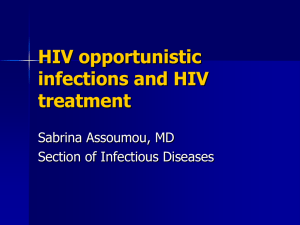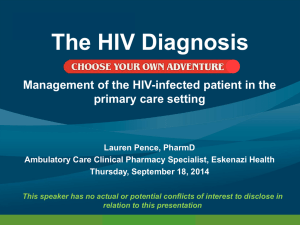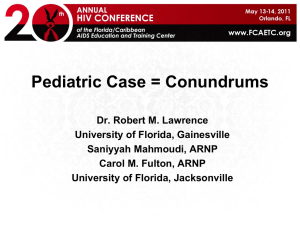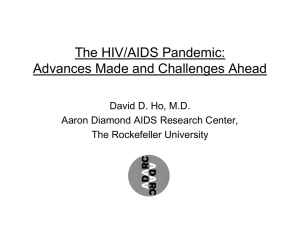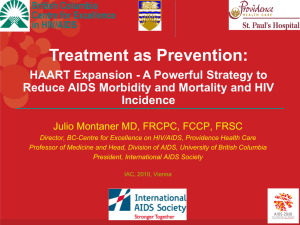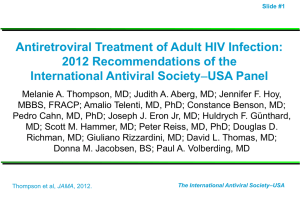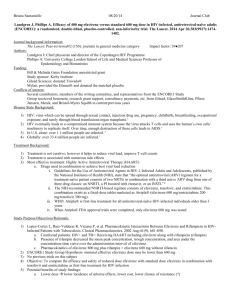HIV/AIDS BOARD REVIEW Harold Henderson, MD
advertisement
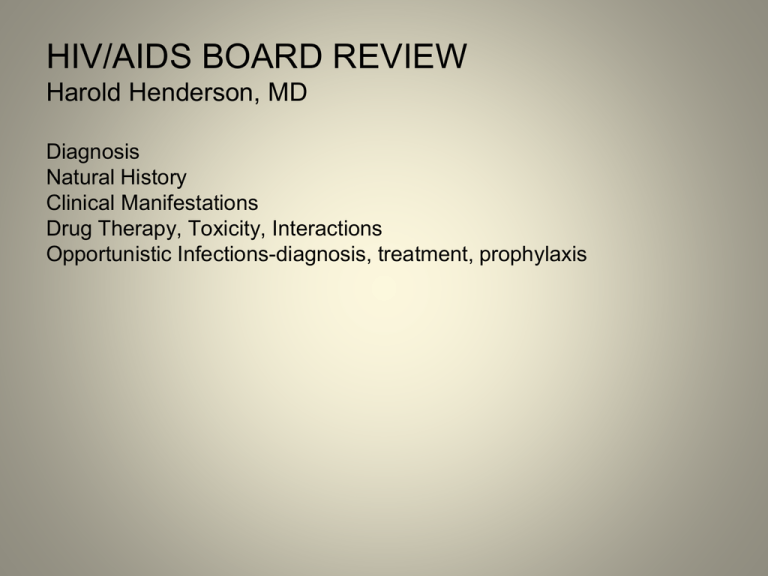
HIV/AIDS BOARD REVIEW Harold Henderson, MD Diagnosis Natural History Clinical Manifestations Drug Therapy, Toxicity, Interactions Opportunistic Infections-diagnosis, treatment, prophylaxis Sample Test Question A 57 y/o healthy adult female with hypertension and diabetes comes to your office for a routine followup appointment. She takes HCTZ and follows an ADA diet for her diabetes. She feels well and has no complaints. She received the influenza vaccine from MSDH 3 days ago. You order HIV serology for routine screening, and the result is a positive EIA but an indeterminate Western Blot. The best explanation for this result is: 1. chronic asymptomatic HIV infection 2. acute HIV infection 3. lab error 4. false positive EIA related to the influenza vaccine DIAGNOSIS EIA-sensitivity/specificity 99%; antibodies usually detectable within 2-6 weeks of acute infection; virtually 100% reactivity by 6 months Needs to be confirmed with Western Blot or IFA; indeterminate results may be due to acute infection period Causes of false negative EIA-acute infection (“window” period) Causes of false positive EIA-hematologic malignancies, autoimmune disorders (SLE), + RPR, influenza and Hep B vaccination Other tests: oral (rapid) test; home test; p24 antigen (may be detectable early in acute infection but <50%); PCR-can be used but false positive and negative rates are too high as screening tool Neonatal diagnosis-maternal antibodies cross placenta and may be detectable for >one year, PCR is test of choice Sample Test Question A 23 y/o male is evaluated in the ER with fever-101°, nausea, malaise and a diffuse, erythematous maculopapular rash for about 3 days. He denies the use of IV drugs but has multiple sexual partners and says “I usually use condoms.” He lives in Jackson and works at a local Target, has always been healthy and takes no meds. PE is normal except for painless, bilateral, 1x2 cm cervical adenopathy. Labs are unremarkable except for a platelet count of 77,000. The best diagnostic test to order is: 1. HIV serology 2. HIV p24 antigen 3. PCR HIV quantitative (viral load) 4. measles serology ACUTE HIV INFECTION SYNDROME Common signs/symptoms (>50%)-fever, adenopathy, pharyngitis, rash (erythematous maculopapular), myalgias Less common-headache, nausea/vomiting, hepatosplenomegaly, weight loss, thrush, neurologic symptoms (aseptic meningitis, meningoencephalitis, Guillain-Barre syndrome), thrombocytopenia EIA usually negative, PCR is test of choice Sample Test Question A 30 y/o HIV+ male is followed by you as his primary care provider. He is asymptomatic and feels well, has a full time job. Lab results (on two separate occasions) include CD4 counts-576 & 553, and viral loads36,000 & 59,000. He is interested in starting HAART if you recommend it. Which of the following is the best treatment plan? 1. Start tenofovir/emtricitabine/efavirenz (Atripla). 2. Delay starting HAART, and follow with repeat CD4s and viral loads every 3-4 months. 3. Start zidovudine/lamivudine (Combivir). 4. Start trimethoprim/sulfamethoxazole as PCP prophylaxis, and follow every 3-4 months. Antiviral TherapyWhen to Start HAART Status Recommendation Symptomatic HIV disease Start therapy for all patients Asymptomatic CD4<500 Start therapy Asymptomatic CD4 > 500 Start therapy Anti-HIV Drug Regimens Minimum number of active drugs is three per combination Usually two NRTIs and one NNRTI (such as AZT/lamivudine/efavirenz) or two NRTs and one protease inhibitor (such as abacavir/lamivudine/lopinavir-ritonavir) PI boosting with ritonavir-commonly done to increase levels of the PI; ritonavir does not count as an antiviral drug in the combination; example: AZT, lamivudine, atazanavir/ritonavir is a 3-drug combination Resistance testing used to help choose initial regimen and to guide salvage regimens after drug failure Current ARV Medications NRTI PI Abacavir (ABC) Didanosine (ddI) Emtricitabine (FTC) Lamivudine (3TC) Stavudine (d4T) Tenofovir (TDF) Zidovudine (AZT, ZDV) Atazanavir (ATV) Darunavir (DRV) Fosamprenavir (FPV) Indinavir (IDV) Lopinavir (LPV) Nelfinavir (NFV) Ritonavir (RTV) Saquinavir (SQV) Tipranavir (TPV) NNRTI Delavirdine (DLV) Efavirenz (EFV) Etravirine (ETR) Nevirapine (NVP) Rilpivirine (RPV) 9 Integrase Inhibitor (II) Dolutegravir (DTG) Elvitegravir* (EVG) Raltegravir (RAL) Fusion Inhibitor Enfuvirtide (ENF, T-20) CCR5 Antagonist Maraviroc (MVC) * EVG currently available only in coformulation with cobicistat (COBI)/ TDF/FTC May 2014 www.aidsetc.org Preferred HAART Regimens for Initial Therapy Tenofovir/emtricitabine/efavirenz (Atripla) Tenofovir/emtricitabine/atazanavir/ritonavir Tenofovir/emtricitabine/darunavir/ritonavir Tenofivir/emtricitabine/raltegravir Tenofovir/emtricitabine/elvitegravir/cobicistat Tenofovir/emtricitabine/dolutegravir Abacavir/emtricitabine/dolutegravir Sample Test Question A 24 y/o HIV positive female, 15 weeks pregnant, is referred to you for medical therapy by her obstetrician, who plans to manage her pregnancy but is not familiar with HIV care. She was recently diagnosed, is asymptomatic, has no other significant past medical history and takes no medications. Lab results include a CD4-535 and a viral load-26,000. An HIV drug susceptibility test shows no drug resistance. Regarding HIV care during her pregnancy, the following is the best plan: 1. She is asymptomatic with a good CD4 count, HAART is not indicated. 2. Start zidovudine (AZT) 300 mg BID. 3. Start tenofovir/emtricitabine/efavirenz (Atripla) 4. Start zidovudine/lamuvidine (Combivir) and lopinavir/ritonavir (Kaletra) HIV and Pregnancy Perinatal transmission of HIV is absence of HAART is 20-30% HAART decreases transmission to <2-3%, all pregnant HIV-infected women should be on HAART after the first trimester Do not use efavirenz-?teratogenic Sample Test Question A 25 y/o male with AIDS (he is asymptomatic but has a CD4 count153, viral load-49,900) is started on zidovudine/lamivudine (Combivir) and efavirenz (Sustiva) as HAART, and TMP/SMZ (Bactrim) SS-one tablet daily as PCP prophylaxis. He returns for followup 8 weeks later. He has no complaints except for very pronounced fatigue for the past two weeks. Lab findings now include a Hct-21 (decreased from 34 six weeks ago), MCV-107, WBC-3.9, a platelet count of 149,000, viral load-undetectable, and a negative FOBT. The following is the best treatment plan: 1. Zidovudine should be stopped, another NRTI should be started in its place, and he should receive a blood transfusion. 2. TMP/SMZ should be stopped, monthly aerosolized pentamidine should be started, and he should receive a blood transfusion. 3. The same medications are continued, and he should receive a blood transfusion. 4. Blood should be obtained for B12 and folate levels, and then he should receive a blood transfusion. Individual NRTI Toxicity-Hematologic AZT-anemia and/or neutropenia Typically early (2-6 weeks), but may occur later in course of therapy May be severe More common in advanced disease with pre-existing bone marrow suppression Generally resolves with drug discontinuation, but resolution may be quite slow NRTI-Hypersensitivity Abacavir, up to 5% incidence Generally occurs within first 8 weeks Characterized by fever, fatigue, nausea, maculopapular rash, with myalgias, cough and dyspnea less common Symptoms occur over several days, and may increase with each dose Predicted by HLA B5701 haplotype Treatment-discontinue the drug Rechallenge may be life-threatening NRTI-Nephrotoxicity Tenofovir may cause proximal renal tubular dysfunction Occasional decrease in creatinine clearance Toxicity is usually mild (average increase in creatinine 0.15) and does not require drug discontinuation Severe nephrotoxicity uncommon (<5%) but does happen Avoid use in patients with pre-existing renal dysfunction ?Use in diabetics and hypertensives Sample Test Question A 37 y/o HIV infected male is admitted from the ER with nausea, vomiting and abdominal pain for 3 days. HIV infection was diagnosed two years ago. He has no other illnesses, has never had an AIDS-defining illness, and on his most recent clinic followup visit one month ago his viral load was undetectable and his CD4 count was 415. He drinks a glass of wine “occasionally” and does not smoke. His medications are tenofovir 300mg qday, didanosine 400mg qday, atazanavir 300mg qday, and ritonavir 100mg qday. Physical exam findings include orthostatic hypotension and diffuse epigastric tenderness. Lab results include a lipase-1163, ALT-177, AST-129, and normal bilirubin. Which of the following statements is best regarding his condition? 1. He has tenofovir-induced pancreatitis. 2. He has alcohol-induced pancreatitis. 3. He has HIV enteropathy. 4. He has didanosine-induced pancreatitis. NRTI-GI Toxicity Pancreatitis-didanosine, uncommon (0.5-5%) but potentially serious; be aware of interaction between ddI and tenofovir (dose of ddI needs adjusting) Hepatotoxicity 1) Mitochondrial toxicity with hepatic steatosis-AZT, stavudine, didanosine 2) Abacavir hypersensitivity 3) Hepatitis B flares-withdrawal or development of resistance to tenofovir, lamivudine, or emtricitabine Test Question A 30 y/o HIV positive male has been on tenofovir/emtricitabine/ indinavir/ritonavir for 14 months. He has never had any other medical problems. He has been asymptomatic, his viral load has gone from its baseline of 114,000 to undetectable and his CD4 count has increased from 258 to 433. He now c/o nausea, right flank pain and gross hematuria for two days, no fever. He had normal baseline renal function, but labs now show WBC-6.1, BUN37 and creatinine-2.2. Urinalysis shows hematuria. The following is the best statement about his condition: 1. He most likely has HIV-induced renal failure and should be referred to a nephrologist. 2. He has tenofovir-induced nephrotoxicity, and the drug should be stopped. 3. He has indinavir-induced nephrotoxicity due to nephrolithiasis, and the drug should be stopped. 4. He most likely has a urinary tract infection. His HAART meds should be continued, and he should be started on empiric antibiotics pending results of a urine culture. TOXICITYINDIVIDUAL PROTEASE INHIBITORS Indinavir (Crixivan)-nausea, diarrhea, nephrolithisis/nephrotoxicity in 10-20% Ritonavir (Norvir)-nausea, diarrhea, circumoral paresthesias 5-10% Nelfinavir (Viracept)-diarrhea Kaletra, fosamprenavir (Lexiva), tipranavir (Aptivus)-GI intolerance atazanavir (Retataz)-increased indirect bilirubin, nephrolithiasis (uncommon) Sample Test Question A 33 y/o HIV positive female has been in good health on HAART (stavudine/lamivudine/lopinavir/ritonavir) for three years. Her most recent CD4 is 345 with an undetectable viral load 8 weeks ago. However she now complains of has 3 weeks of worsening fatigue, anorexia, and nausea, and she has lost 12 lbs during that time. Physical exam is unremarkable. Initial lab results include an AST-111, ALT-128, total bilirubin-0.8, lipase-126, Na-138, K-3.8, Cl-102, CO2-16, BUN-24, creatinine-1.4 and a normal CBC. The best diagnostic test(s) at this time is: 1. CT of the abdomen/pelvis 2. CK and aldolase levels 3. Arterial Blood Gases 4. lactic acid level Lactic Acidosis Syndrome Symptomatic disease uncommon, 0.5-1/100 patient years of NRTI exposure Most strongly associated with d4T(stavudine) and d4T/ddI use; other risk factors are pregnancy, ddI (didanosine) with ribavirin or hydroxyurea Non-specific symptoms: fatigue, nausea, vomiting, diarrhea, abdominal discomfort or distention; hepatic steatosis Higher lactic acid levels (>10mM) have worse prognosis Therapy: stop “d” drug, supportive care, ?vitamins No value to monitor lactic acid in absence of symptoms Sample Test Question A 35 y/o male with AIDS (last CD4-97) is in your care. He also has peripheral neuropathy and hyperlipidemia. His medications are tenofovir/emtricitabine/efavirenz (Atripla), TMP/SMZ (Bactrim), simvastatin, and gabapentin. He now c/o myalgias, anorexia and fatigue for two weeks. Lab results include total cholesterol-235, LDL161, AST-205, ALT 187, and CK-851. The best plan at this time is: 1. Increase simvastatin dose for better treatment of his hyperlipidemia. 2. Stop simvastatin because on interaction with efavirenz is causing drug toxicity. 3. Stop tenofovir because of tenofovir-related hepatotoxicity. 4. Stop tenofovir because of tenofovir-related myopathy. Drug Interactions and Anti-HIV Agents Lipid-lowering agents (statins) PIs, efavirenz (statin) use pravastatin or rosuvastatin (minimal) or atorvastatin (moderate) Anticonvulsants phenytoin, carbamazepine, phenobarbital-monitor levels most PIs Miscellaneous methadone-some PIs, nevirapine, efavirenz sildenafil, vardenafil-most PIs warfarin-most PIs, efavirenz Drug Interactions and Anti-HIV Agents Antifungals • itraconazole-most PIs ( itra), nevirapine and efavirenz ( itra) • voriconazole-ritonavir, efavirenz ( vori) Antimycobacterials rifampin-all PIs, nevirapine, rifabutin-all PIs, nevirapine, efavirenz (but <rifampin) clarithromycin-most PIs, nevirapine, efavirenz Oral contraceptives most PIs, nevirapine, efavirenz PCP (Pneumocystis jiroveci)-Clinical features Usually a CD4 < 200, co-existent thrush common Sub-acute presentation (weeks) Common symptoms-fever, weight loss, progressive DOE, cough Hypoxemia CXR-bilateral, interstitial infiltrates most common; normal, pneumothorax less common Diagnosis-induced sputum (poorly sensitive), BAL >95% sensitivity; LDH and galactomannan may also be useful PCP-Treatment Preferred-Trimethoprim/sulfamethoxazole 15-20 mg/kg/day in 3-4 divided doses IV or oral (Bactrim DS two tabs TID PO) Hypoxemia-use steroids if room air PO <70mm or A-a gradient >35mm Response to therapy may be slow (5-7 days) Alternatives: trimethoprim/dapsone pentamidine IV clindamycin/primaquine atovoquone Tuberculosis Much more common in setting of HIV disease May have typical pulmonary TB at higher CD4 counts, atypical presentation very common at CD4 <100extrapulmonary/disseminated TB and CXR may show infiltrates or miliary pattern without cavitation Diagnosis with AFB smears/culture/biopsy High false-negative rate with PPD Treatment-4 anti-TB drugs to start; beware of rifampin and drug interactions Response to therapy similar to HIV negative persons OPPORTUNISTIC INFECTION QUESTION A 36 y/o HIV infected male, CD4-33, is brought to the ER with 5 days of fever and headache. He has not been in care for more than one year and is taking no meds. He is lethargic on exam and has white patches on his tongue and buccal mucosa. An MRI of the head shows focal, enhancing lesions with surrounding edema-2 in right parietal lobe and one in left basal ganglia. The best evaluation/treatment plan is: 1. Obtain an LP to evaluate for cryptococcal meningitis. 2. start pyrimethamine and sulfadiazine 3. consult neurosurgery for brain biopsy 4. start HAART as therapy for AIDS-related PML CNS TOXOPLASMOSIS Most common cause of brain abscess CD4 usually <100 Common presentation-fever, headache, altered mental status, focal neurologic deficits, seizure Diagnosis: Toxo serology positive in 95%; CNS imaging usually shows multiple, bilateral, ring-enhancing lesions; single lesions may be confused with lymphoma Treatment: pyrimethamine/sulfadiazine leucovorin, dexamethasone for mass effect due to edema; alternatives include pyrimethamine/clindamycin and Bactrim Clinical and/or radiographic improvement in 1-2 weeks CRYPTOCOCCAL MENINGITIS Most common cause of meningitis Extra-meningeal disease less common, sometimes with papular skin lesions CD4 usually <100 Usual presentation-subacute with fever, headache, altered mental status, seizure Diagnosis-CSF crypto antigen, culture, India Ink smear; blood cultures; serum CAG positive in >95% Treatment-initial (7-14 days) period of amphotericin with flucytosine, followed by fluconazole 400 mg qday x 8 weeks, then to 200 mg qday Elevated intracranial pressure-common, important cause of morbidity and mortality; treat with serial LPs or VP shunt CMV DISEASE Retinitis most common, CD4 usually <50 Common presentation-floaters, visual field defect, loss of visual acuity Diagnosis via funduscopic exam by ophthalmologist Treatment: valgancyclovir 900 mg BID P0 x 14-21 days (systemic therapy required) with or without intraocular gancyclovir implant; alternatives include gancyclovir, foscarnet, and cidofovir; avoid AZT CMV GI disease: usually esophagitis or colitis, biopsy for diagnosis, treat with valgancyclovir CMV neurologic disease: encephalitis: lethargy, confusion, fever; dx-CMV PCR of CSF radiculopathy: rapidly progressive leg paresis, bowel and bladder dysfunction PML-Polymorphonuclear Leukoencephalopathy Caused by JC viral infection of CNS CD4 usually <200 Common presentation-progressive cognitive and motor dysfunction over weeks to months; no fever MRI of head shows hypodense lesions of white matter; CT not as sensitive Diagnosis: compatible clinical syndrome and imaging study with positive JC viral PCR of CSF (sensitivity-80%); also brain biopsy Treatment-HAART; no effective direct treatment known Candidiasis and HIV Infection Oral candidiasis-very common, CD4 usually <300; can be treated with local or systemic antifungal therapy; avoid chronic, daily use of azoles Esophageal candidiasis thrush usually present, CD4 usually <100 Symptoms: dysphagia, usually no fever; odynophagia suggests esophageal ulceration Treatment: fluconazole 200 mg daily for 14-21 days, response usually within 7 days Alternatives for fluconazole-refractory disease include itraconazole elixir PO, IV amphotericin B or IV caspofungin DISSEMINATED MAC-MYCOBACTERIUM AVIUM COMPLEX Usually CD4 <50 Typical presentation-subacute fever, night sweats, weight loss, diarrhea, anemia and neutropenia Diagnosis via culture from blood or visceral organ; positive MAC cultures of sputum or stool document colonization only Treatment HAART clarithromycin plus ethambutol plus/minus rifabutin, prolonged therapy necessary watch for clarithromycin or rifabutin drug interactions DISSEMINATED HISTOPLASMOSIS CD4 usually <200 Common symptoms include fever (may be up to 105°), fatigue, weight loss, nausea and diarrhea Multiorgan disease with lung, CNS, GI tract, liver, or bone marrow involvement Diagnosis-cultures of blood or BM, visualization of organisms in peripheral blood or BM biopsy, urine Histo antigen (>90% sensitive) Treatment: severe disease: amphotericin B initially, followed by itraconazole mild to moderate disease: itraconazole 200 mg BID x 8-12 weeks, then to 100 mg BID as maintenance HERPES SIMPLEX Any CD4 count Orolabial and genital ulcerative lesions common; with advanced AIDS lesions may be more extensive, and may disseminate Disease tends to be more extensive and refractory to therapy in AIDS Treatment: acyclovir 400 mg TID for 7-10 days for typical lesions, famcyclovir or valacyclovir also effective Severe disease: may need IV therapy initially, more prolonged course acyclovir-resistant disease-foscarnet IV or cidofovir IV visceral organ involvement/encephalitis-high-dose acyclovir IV chronic suppressive therapy for frequent recurrences or advanced AIDS HIV-RELATED MALIGNANCIES Kaposi’s sarcoma-caused by HHV-8, CD4 usually <300, brown/violaceous skin macules/nodules, may cause visceral organ involvement, much less common in HAART era Cervical cancer-associated with HPV, regular screening PAP smears in women recommended to monitor for dysplasia Non-Hodgkin’s Lymphoma-CD4 usually <100, associated with EBV, often high-grade, multiple presentations possible including primary effusion lymphoma, prognosis much better in HAART era CNS Lymphoma-CD4 usually <50, associated with EBV, MRI-irregular enhancing lesions often single by may be multiple usually in periventricular or periependymal areas, thallium SPECT scan helpful OIs-PRIMARY PROPHYLAXIS PCP risk: CD4 <200, prior PCP or thrush preferred: TMP-SMX qday alternatives: dapsone 100 mg qday, weekly dapsone/pyrimethamine, aerosolized pentamidine monthly, atovaquone qday immune reconstitution: stop prophylaxis if CD4 >200 for >3 months • TB risk: positive PPD (>5mm) or recent close contact preferred: INH x 9 months OIs-PRIMARY PROPHYLAXIS Toxoplasmosis risk: CD4 <100 plus positive Toxo serology preferred: TMP-SMX qday alternatives: dapsone plus pyrimethamine immune reconstitution: stop prophylaxis if CD4 >200 for >3 months •Disseminated MAC risk: CD4 <50 preferred: azithromycin 1200 mg qweek or Biaxin 500 mg BID alternative: rifabutin 300 mg qday immune reconstitution: stop prophylaxis if CD4 >100 for >3 months
